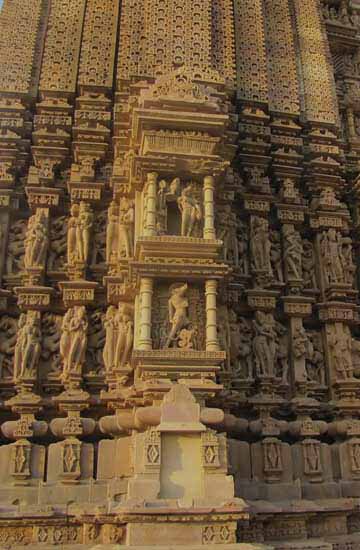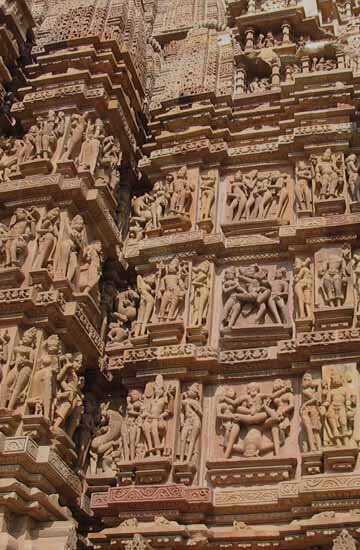Kandariya Mahadev Temple (3 Km) -
The temple complex takes over an area of 6 square kilometers. It is located on the western part of the village and to the west of the Vishnu temple. It is the biggest among the three groups of the Khajuraho temple complexes. This western group of temples, consisting of the historically rich Kandariya, the majestic Matangeshwar and the spectacular Vishwanath temples, is often compared with a cosmic design of a hexagon. It is said to represent the three forms of the Hindu god Shiva. The temple’s architecture is a blend of porches and towers. They are in the form of a shikhara. This feature was typical of the 10th century architecture of central India.
Chaunsath Yogini (3 Km) +
The temple is the earliest temple of the group that has survived. It belongs to 900 AD and is dedicated Goddess Kali. It has the distinction of being the only granite temple here.
Chitragupta Temple (6 Km) +
Situated on the top of a hill in Khajuraho, Trimukhi temple is known to be one of the oldest temples in India. Also known as 'Karna Mandir', after King Karnadeb Mahachandra, who built it and was constructed under the reign of the Kalachuris. The temple is dedicated to Lord Shiva, the destroyer of the universe as per Hindu mythology. The top of the temple is sculpted with the face of Lord Shiva. This shows the immense intricacies carved out by the Kalchuri craftsmen. It is in close proximity to other attractions like Dudh Dhara Falls, Sonmuda, Kabir Chabutra, Mai ki Bagiya and Bhrugu Ka Mandal are some of the other places of tourist interest near the Trimukhi temple.
Sonakshi Shaktipeeth Temple (3 Km) +
This temple is dedicated to the Sun God (Surya Dev). It faces towards east or the rising sun and the imposing image of the image of the deity in the inner sanctum is as high as five feet and is shown driving a horse-drawn chariot. It is in front of this temple and the Vishwanatha temple that most of the dance performances take place during the Khajuraho Dance Festival.
Vishwanath Temple (4 Km) +
It is a temple having great religious significance in the Hindu mythology and must not be missed on the one day Khajuraho tour. It is a part of the western group of Khajuraho Monuments. It has been declared as a UNESCO World Heritage site. It is dedicated to Shiva, whose other name is “Vishvanatha”. It showcases the Central Indian style of architecture that began with the Lakshmana Temple and culminated with the Kandariya Mahadeva Temple. These temples exhibit the most fully developed style at Khajuraho. The Vishvanatha site was also built as a panchayatana complex. It consists of one main shrine. It is surrounded by four small subsidiary shrines. Only two of the smaller shrines have survived the ravages of time. The shrine in the south-western side is dedicated to Shiva’s wife Parvati, which is partly damaged.
Lakshmana Temple (2 Km) +
It is situated on the Western complex, and one of the most beautiful temples in the Khajuraho private tour. It is a part of the Sandhara Temples of the Panchayatana Variety. The entire temple complex stands on a Jagati, as in a high platform. The structure is a mixture of all the facets of typical Hindu temple architecture. It has an entrance porch that is commonly referred to as the ardha-mandapa. It also has a maha-mandapa, an Antarala, and a pretty fascinating Garbhagriha. Unlike other temples found here, Lakshman temple’s sanctum is a sculpture of Pancharatha. Its shikhara is thronged by minuscule urushringas.
Matangeshwara Temple (3 Km) +
Situated outside the premises of Western group of temples, this Lord Shiva's temple is known for the daunting eight-foot high lingam (male organ representing the natural process of reproduction and the continuity of human life form) that it enshrines.
Parsvanatha Temple (4 Km) +
The largest Jain temple of the Eastern group, Parsvanath temple has intricate stone carvings, especially, the sculptures on the northern outer wall of the temple are certainly praiseworthy. It enshrines a throne facing the bull emblem that represents the the first tirthankara, Adinatha.
Ghantai Temple (4 Km) +
This Jain temple has remarkable frescos depicting the 16 dreams of the mother of Lord Mahavira at the time of his birth and a Jain goddess mounted on a winged Garuda.
Adinatha Temple (4 Km) +
This temple is richly ornamented with delicate and pretty scultures including those of yakshis. It is dedicated to the first Jain tirthankara (saint), Adinath. Most of the temple here belongs to Jain faith but there are three Hindu temples of the group, namely, the Brahma temple enshrining a four-faced linga; the Vamana temple with divine carvings of sensuous celestial maidens in various poses adorning its outer walls and the Javari temple with a opulently carved doorway and ostentatious sculptures on its exteriors.
Devi Jagadamba Temple (3 Km) +
Devi Jagdamba temple was also declared a World Heritage Site by UNESCO. Like most other temples in Khajuraho, this too was built by the Chandella dynasty sometime between the 10th and the 12th century. Devi Jagadamba temple lies on the northern part of Khajuraho. Devi Jagdamba Temple is one of the most intricately decorated temples in India. Three bands of carvings surround the temple. In the sanctum, there is a huge image of the Devi. The temple stands on a raised platform. The squared roof of its maha-mandapa is much more simply decorated than the octagonal ceiling of the Chitragupta temple. Photography inside the temple is strictly forbidden.
Dulhadeo Temple (3 Km) +
This temple was built to honor the Hindu god Shiva in the form of a linga, which is kept in the sanctum. ‘Dulhadev’ means “Holy Bridegroom”. The temple is also referred to as “Kunwar Math”. It faces east and was built sometime between 1000–1150 AD. It is the also one of the last temples built during the Chandella period. The temple is built on the seven chariot plan (saptaratna). The figurines etched on the sides of the temple have soft expressive features that are very unlike of other temples of Khajuraho. The walls have a display of carved celestial dancers called apsara and other figures. Dulhadev temple is found along the banks of the Khodar River in the southern group of the Khajuraho Group of temples.
Chaturbhuja Temple (3 Km) +
It is the huge imposing intricately carved image of Lord Vishnu in the temple's sanctum, which is the chief attraction of the temple.
After the completion of your tour, you will be dropped back to your place within Khajuraho city limits.



